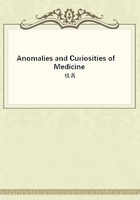
第90章
In commenting upon this, after reviewing several similar cases of endocymian monsters that came under his observation in Mexico, Rodriguez tells what the case which had been so grossly exaggerated by the lay journals really was: An Indian boy, aged twenty-two, presented a tumor in the sacrococcygeal region measuring 53 cm. in circumference at the base, having a vertical diameter of 17 cm. and a transverse diameter of 13 cm. It had no pedicle and was fixed, showing unequal consistency. At birth this tumor was about the size of a pigeon's egg. A diagnosis of dermoid cyst was made and two operations were performed on the boy, death following the second. The skeleton showed interesting conditions; the rectum and pelvic organs were natural, and the contents of the cyst verified the diagnosis.
Quite similar to the cases of fetus in fetu are the instances of dermoid cysts. For many years they have been a mystery to physiologists, and their origin now is little more than hypothetic. At one time the fact of finding such a formation in the ovary of an unmarried woman was presumptive evidence that she was unchaste; but this idea was dissipated as soon as examples were reported in children, and to-day we have a well-defined difference between congenital and extrauterine pregnancy. Dermoid cysts of the ovary may consist only of a wall of connective tissue lined with epidermis and containing distinctly epidermic scales which, however, may be rolled up in firm masses of a more or less soapy consistency; this variety is called by Orth epidermoid cyst; or, according to Warren, a form of cyst made up of skin containing small and ill-defined papillae, but rich in hair follicles and sebaceous glands. Even the erector pili muscle and the sudoriparous gland are often found. The hair is partly free and rolled up into thick balls or is still attached to the walls. A large mass of sebaceous material is also found in these cysts. Thomson reports a case of dermoid cyst of the bladder containing hair, which cyst he removed. It was a pedunculated growth, and it was undoubtedly vesical and not expelled from some ovarian source through the urinary passage, as sometimes occurs.
The simpler forms of the ordinary dermoid cysts contain bone and teeth. The complicated teratoma of this class may contain, in addition to the previously mentioned structures, cartilage and glands, mucous and serous membrane, muscle, nerves, and cerebral substance, portions of eyes, fingers with nails, mammae, etc.
Figure 64 represents a cyst containing long red hair that was removed from a blonde woman aged forty-four years who had given birth to six children. Cullingworth reports the history of a woman in whom both ovaries were apparently involved by dermoids, who had given birth to 12 children and had three miscarriages--the last, three months before the removal of the growths. The accompanying illustration, taken from Baldy, pictures a dermoid cyst of the complicated variety laid open and exposing the contents in situ. Mears of Philadelphia reports a case of ovarian cyst removed from a girl of six and a half by Bradford of Kentucky in 1875. From this age on to adult life many similar cases are recorded. Nearly every medical museum has preserved specimens of dermoid cysts, and almost all physicians are well acquainted with their occurrence. The curious formations and contents and the bizarre shapes are of great variety. Graves mentions a dermoid cyst containing the left side of a human face, an eye, a molar tooth, and various bones. Dermoid cysts are found also in regions of the body quite remote from the ovary. The so-called "orbital wens" are true inclusion of the skin of a congenital origin, as are the nasal dermoids and some of the cysts of the neck.
Weil reported the case of a man of twenty-two years who was born with what was supposed to he a spina bifida in the lower sacral region. According to Senn, the swelling never caused any pain or inconvenience until it inflamed, when it opened spontaneously and suppurated, discharging a large quantity of offensive pus, hair, and sebaceous material, thus proving it to have been a dermoid.
The cyst was freely incised, and there were found numerous openings of sweat glands, from which drops of perspiration escaped when the patient was sweating.
Dermoid cysts of the thorax are rare. Bramann reported a case in which a dermoid cyst of small size was situated over the sternum at the junction of the manubrium with the gladiolus, and a similar cyst in the neck near the left cornu of the hyoid bone.
Chitten removed a dermoid from the sternum of a female of thirty-nine, the cyst containing 11 ounces of atheromatous material. In the Museum of St. Bartholomew's Hospital in London there is a congenital tumor which was removed from the anterior mediastinum of a woman of twenty one, and contained portions of skin, fat, sebaceous material, and two pieces of bone similar to the superior maxilla, and in which several teeth were found.
Dermoids are found in the palate and pharynx, and open dermoids of the conjunctiva are classified by Sutton with the moles.
According to Senn, Barker collected sixteen dermoid tumors of the tongue. Bryk successfully removed a tumor of this nature the size of a fist. Wellington Gray removed an enormous lingual dermoid from the mouth of a negro. It contained 40 ounces of atheromatous material. Dermoids of the rectum are reported. Duyse reports the history of a case of labor during which a rectal dermoid was expelled. The dermoid contained a cerebral vesicle, a rudimentary eye, a canine and a molar tooth, and a piece of bone. There is little doubt that many cases of fetus in fetu reported were really dermoids of the scrotum.